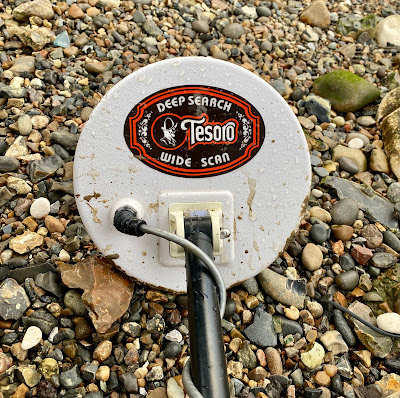Audio Response 'In Regards To Masked Targets'
Because I don't use machines with readouts and screens I have to understand what I'm hearing and the only way I learn this is by using my detectors as much as possible. Nothing beats real world hunting but above ground tests can help a lot because you start to memorise certain audio responses. This blog is going to explain about "Audio Response In Regards To Masked Targets"
For instance, after testing my Tesoro machines with their 7' inch DD wide scan coils, I was genuinely impressed with their ability to separate and unmask targets in both 3D and same plain tests. I understand that the DD configuration coils are limited regarding the angles they can see a target masked by iron, but that doesn't bother me to much. I hunt slow and when I'm using DD coils I'll search the same ground from all different directions and angles. This gives me a higher chance at hitting on something that's masked, let us remember that on the river 100's of targets are masked and if you don't know what to listen for then you're wasting your time. Messing around with my machines and coils and conducting certain tests above ground enables me to hear certain audio responses that I can take with me to the river.
 |
| 7' Inch DD Wide Scan Coin |
What Do I Mean By This? certain target situations will produce a certain audio response, and if you memorise what you're hearing, when you come across a similar "sound" out in real world hunting, it can be easier to interpret what your machine is trying to tell you. After experimenting with unmasking tests I understand the limitations of the coils that I use. To get the most out of them I need to be aware of both their strengths and weaknesses, for example, concentric coils have the upper hand in iron due to the amount of angles they can hit on a masked target from. As mentioned before, DD coils are limited in this regard BUT .... they still give "Tells" when you're using them in iron. This is something that I've learnt to listen for whilst hunting so much on the river, it's from these "Tells" that you can hone in your swing and try to isolate what you perceive to be a target that is masked.
If I'm swinging and I suddenly get a small, clipped audio, I'll see if I can isolate it, this means I minimise my swing whilst rotating on the signal. If the response clips and spits without producing a dominant high tone it's usually iron. If the signal response opens up and I can hit on it with both swings, this tells me that I have a nonferrous target under the coil. It's from this point that you can start to gauge the size of the target, on my Tesoro machines, a tiny nonferrous signal can easily be mistaken for a false signal if you're not paying attention and swinging too fast. To isolate the tiny targets you have to go nice and slow, this allows the detector to latch on. I believe Tesoro machines work best swinging them nice and slow, this gives the detector the chance to do it's job properly.
When using my DD coils, rotating 360 on what I believe to be a masked target can also improve results. What Do I Mean By This? If I'm casually swinging and I get an uncertain sounding response, I'll try to isolate it as I slowly rotate. Due to the way double DD coils work, if it's a potential nonferrous target being masked, the machine will hit on it from a limited amount of angles before the signal disappears. This is enough to tell me that a good target is there. However, this is when using a concentric coil can be a huge advantage because they're not effected in the same way as a DD coil is. More times than not a CC will hit on a masked target from all angles and you'll be able to rotate 360 with a distinct high tone. To put it bluntly, you will hit on more targets in iron with a CC.
 |
| 7' Inch CC Coil Is An Advantage In Iron |
But let us remember my last video where I demonstrate the 8' inch CC failing to match the 7' inch DD wide scan coil and its ability to see a silver coin under two iron nails. My advice when running any Tesoro unit in iron would be to use a CC coil no bigger than 7' inches. The video that I'm referring to is posted below, I found the results interesting. To wrap this blog up, when you understand the audio of your machine you will find more targets in all the hunting situations that you find yourself in. As pointed out at the start of this blog, above ground tests allow you to memorise different audio responses depending on the situation under the coil. The more you memorise and recognise when you're out in the field the more good non-ferrous targets you'll walk away with at the end of the day.


Don't know how to get that anonymous shit off the top so I'll leave my name at the end ,me being a dumb fuck and all.follk
ReplyDeleteJust read your last carp blog .Still laughing, you should say what you mean ha ha. Ever thought of running for government? You've got my vote .
If your ever in the Highlands look me up ,a pair of anti social bastard metal detecting strange
Two many words so continued.
ReplyDeleteStrange folk. Sean emmett .I'm not hiding.